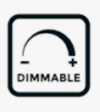Daughter phoned last night around 8pm...
2G switch 4 off 3C&E (2 old colours, 2 harmonised), 1 off T&E and 2off chockbloc's. My grandson (19) said it would be easy to change and brought one home from Screwfix where he works...
It took a little bit of head scratching, both switches labelled as L1, L2, L3. He says one switch had 2 wires in L1,L2 t'other had 2 wires in L3. Now it's tripping the RCBO's.
So the great thing about standards: old switch L3 = COM (no make that I could find), new switch L1 = COM. One gang wired as the end of conventional 2W with Neutral coming along the strappers feeding 2 wall lights, the other gang presumably wired as conversion method with a spare neutral from the 3 plate system.
2G switch 4 off 3C&E (2 old colours, 2 harmonised), 1 off T&E and 2off chockbloc's. My grandson (19) said it would be easy to change and brought one home from Screwfix where he works...
It took a little bit of head scratching, both switches labelled as L1, L2, L3. He says one switch had 2 wires in L1,L2 t'other had 2 wires in L3. Now it's tripping the RCBO's.
So the great thing about standards: old switch L3 = COM (no make that I could find), new switch L1 = COM. One gang wired as the end of conventional 2W with Neutral coming along the strappers feeding 2 wall lights, the other gang presumably wired as conversion method with a spare neutral from the 3 plate system.



